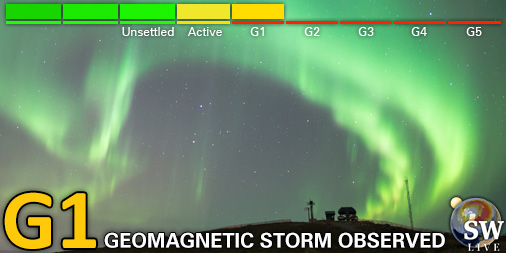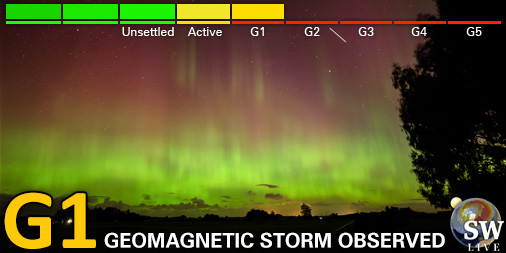Het archief bekijken van zondag 4 november 2001
Activiteitenrapport
Opgemaakt door de NOAA © SWPC en verwerkt door Poollicht.be
USAF/NOAA rapport van de zonneactiviteit en geofysische activiteit
SDF Nummer 308 gepubliceerd omstreeks 2200Z op 04 Nov 2001IA. Analyse van de actieve zonneregio's en zonneactiviteit van 03-2100Z tot 04-2100Z
IB. Voorspelling zonneactiviteit
IIA. Samenvatting geofysische activiteit 03-2100Z tot 04-2100Z
IIB. Voorspelling geofysische activiteit
III. Kans zonnevlammen van 05 Nov tot 07 Nov
| Klasse M | 80% | 80% | 80% |
| Klasse X | 25% | 25% | 25% |
| Proton | 99% | 80% | 25% |
| PCAF | in progress | ||
IV. Penticton 10.7 cm Flux
Geobserveerd 04 Nov 227 Voorspeld 05 Nov-07 Nov 220/215/210 90 dagen gemiddelde 04 Nov 206
V. Geomagnetische A index
Geobserveerd Afr/Ap 03 Nov 001/003 Geraamd Afr/Ap 04 Nov 007/008 Voorspeld Afr/Ap 05 Nov-07 Nov 015/015-050/050-025/025
VI. Kansen op geomagnetische activiteit van 05 Nov tot 07 Nov
| A. Gemiddelde breedtegraad | |||
|---|---|---|---|
| Actief | 25% | 10% | 20% |
| Kleine storm | 15% | 15% | 35% |
| Zware-ernstige stormcondities | 15% | 75% | 35% |
| B. Hoge breedtegraad | |||
|---|---|---|---|
| Actief | 25% | 05% | 15% |
| Kleine storm | 15% | 10% | 30% |
| Zware-ernstige stormcondities | 15% | 80% | 35% |
Alle tijden in UTC
<< Keer terug naar de dagelijkse overview pagina
Op basis van de huidige parameters is er in de nabije toekomst een matige kans op poollicht op de volgende locaties van de hoge breedtegraad
ReykjavikOp basis van de huidige parameters is er in de nabije toekomst een beperkte kans op poollicht op de volgende locaties van de hoge breedtegraad
TórshavnOulu, Rovaniemi, Kuopio, Sodankylä
Tromsø, Trondheim
Arkhangelsk
Kiruna, Luleå, Sundsvall, Umeå
Laatste nieuws
Laatste forumberichten
Steun Poollicht.be!
Om ook bereikbaar te blijven bij grote poollichtkansen hebben we een zware server nodig die alle bezoekers aankan. Doneer en steun dit project zodat we online blijven en je geen enkele poollichtkans mist!

Laatste alerts
20:30 UTC - Geomagnetische activiteit
G1 - Kleine geomagnetische storm (Kp5) Drempel bereikt: 20:20 UTC
20:24 UTC - Zonnevlam
Matige M1.05 zonnevlam
20:09 UTC - Radio blackout
Kleine R1 radio blackout gedetecteerd (≥M1 - momenteel: M1.05)
10:00 UTC - Hemisferisch vermogen
Het OVATION-model voorspelt dat het hemisferisch vermogen 78GW zal bereiken om 10:32 UTC
04:15 UTC - Geomagnetische activiteit
G1 - Kleine geomagnetische storm (Kp5) Drempel bereikt: 04:05 UTC
Ruimteweer feitjes
| Laatste X-klasse uitbarsting | 28/03/2025 | X1.1 |
| Laatste M-klasse uitbarsting | 05/04/2025 | M1.0 |
| Laatste geomagnetische storm | 04/04/2025 | Kp5+ (G1) |
| Zonnevlekkenloze dagen | |
|---|---|
| Laatste zonnevlekkenloze dag | 08/06/2022 |
| Maandelijks gemiddeld zonnevlekkengetal | |
|---|---|
| maart 2025 | 134.2 -20.4 |
| april 2025 | 148 +13.8 |
| Afgelopen 30 dagen | 130.7 -14.4 |





